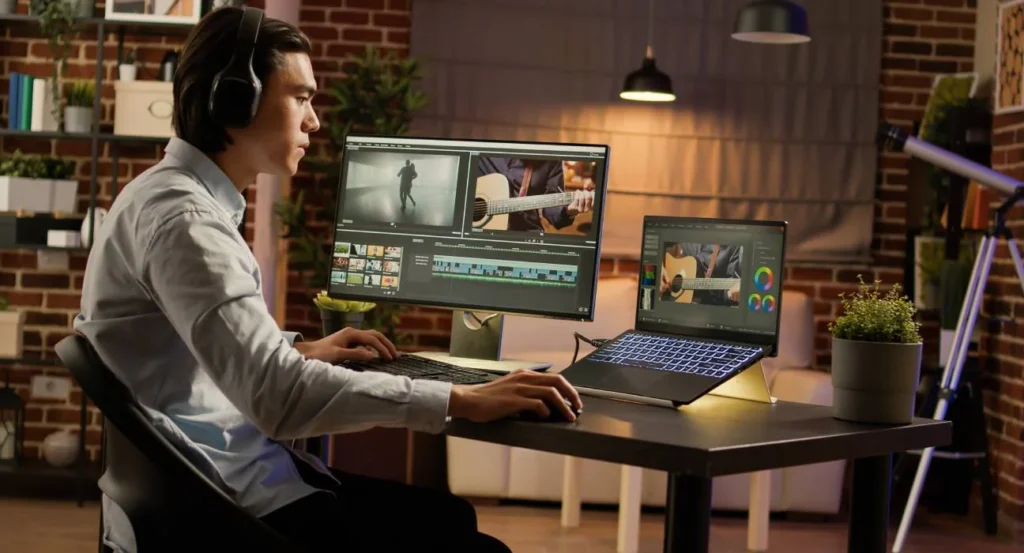We live in a world where attention is currency—and editing is the gatekeeper.
Whether it’s a cinematic film, a YouTube vlog, or a 15-second Instagram reel, the way a video is edited decides one thing:
Will the viewer stay, or will they scroll away?
Welcome to the psychology of editing—a hidden force that plays with emotions, perception, and engagement. At Vistaar, where stories come to life, we know that editing isn’t just about cutting and trimming. It’s about understanding the human brain and crafting a narrative that captures it, holds it, and moves it.
Let’s break down how editing influences viewer behavior, and why a simple cut can make the difference between binge-watching and bouncing.
First Impressions Are Everything: The First 3 Seconds
The harsh truth?
You’ve got 3 seconds—sometimes even less—to capture your audience.
In today’s content-heavy world, viewers are constantly scrolling. If your video doesn’t hook them instantly, they’re gone. This is where editing psychology kicks in.
Here’s what works:
- Quick, clear visuals: No slow intros. Show something striking upfront.
- Sound cues: A sudden beat drop or sound effect grabs attention.
- Movement: Rapid motion draws the eye, so editors often open with action or transitions.
🔹 Psych Tip: The brain is wired to notice contrast. Use it. Whether it’s light/dark, sound/silence, or calm/chaos—starting with a stark difference grabs focus.
The Emotional Journey: Storytelling Through Structure
Humans don’t just love stories—we need them. Editing determines how we emotionally connect to those stories.
An effective edit follows a story arc, even in a short video:
- Hook (the setup)
- Build-up (tension/emotion)
- Climax (conflict or highlight)
- Resolution (message or takeaway)
Even a 30-second reel can follow this arc. If a video lacks this emotional rhythm, the viewer loses interest—because their brain isn’t being rewarded.
🔹 Psych Tip: Emotional editing creates dopamine spikes. Make viewers feel something—curiosity, excitement, laughter, empathy. They’ll stay for the ride.
Cuts That Keep You Watching: The Invisible Language
Editing is like a silent language—every cut speaks, even if the viewer doesn’t realize it.
Smooth, rhythmic cuts make a video feel seamless. Jarring or awkward cuts, on the other hand, confuse the brain. If a viewer gets mentally “knocked out” of the flow, they’ll scroll.
That’s why great editors focus on:
- Continuity: Logical flow from one scene to another
- Pacing: Not too fast to overwhelm, not too slow to bore
- Timing: Holding just enough on a shot to make it meaningful
🔹 Psych Tip: The brain loves closure. End your shots on a completed action, reaction, or expression. It gives the mind a sense of satisfaction.
Sound Matters More Than You Think
A well-edited video isn’t just about visuals—it’s about audio. What you hear affects how you feel and whether you stay engaged.
- Music sets mood and tone instantly
- SFX (sound effects) highlight actions and transitions
- Silence, when used well, builds tension or emotion
Ever watched a video on mute and felt… nothing? That’s how much audio impacts engagement.
🔹 Psych Tip: The brain responds emotionally to music and rhythm. Syncing cuts to beats or emotional soundtracks increases retention.
Text and Titles: Guiding the Brain
Today, most videos are watched without sound, especially on mobile. That’s why captions, text overlays, and motion graphics have become crucial.
Good editing uses on-screen text to:
- Emphasize key points
- Keep the viewer visually engaged
- Provide clarity when audio isn’t an option
But here’s the catch: Overusing text can backfire. Keep it minimal, well-timed, and meaningful.
🔹 Psych Tip: The brain craves clarity. If viewers have to work hard to understand what’s happening—they’ll scroll.
Pattern Interrupts: The Secret Weapon
Ever noticed how you’re watching a video and suddenly something unexpected happens—like a color shift, angle change, or visual glitch—and you keep watching?
That’s called a pattern interrupt.
The human brain zones out when things are too predictable. Editors use sudden changes in:
- Camera angle
- Color grading
- Zoom cuts or digital pans
- Sound design To jolt the brain and regain attention.
🔹 Psych Tip: Break patterns, but not rhythm. Keep surprising the viewer while maintaining a consistent tone.
Call to Action: Ending with Purpose
How you end a video matters. The final seconds are your chance to direct the viewer—to like, share, comment, watch more, or simply reflect.
An abrupt or flat ending feels incomplete. A meaningful close—like a quote, a question, or an emotional resolution—gives the brain closure and increases memory retention.
🔹 Psych Tip: The Recency Effect means we remember the last thing we see. End powerfully.
Why This Matters at Vistaar
At Vistaar, we understand that editing isn’t just a post-production task—it’s the soul of the story. Whether it’s a feature film, a college project, a brand campaign, or social media content, our editors are trained not just in software—but in psychology.
We edit with empathy. We don’t just ask “What looks good?”—we ask “How will this make the viewer feel?”
Because in the end, people don’t remember videos for their effects or transitions.
They remember how those moments made them feel.
And that feeling… is created in the edit room.
Final Thoughts
The psychology of editing is simple:
If you understand how the brain works, you can keep viewers hooked, engaged, and emotionally invested.
Great editing isn’t flashy. It’s invisible, intentional, and emotional.
So the next time you scroll, pause and ask—what made you stop? What made you feel something? What made you stay?
Chances are, an editor crafted that moment—with purpose, with skill, and with heart.

